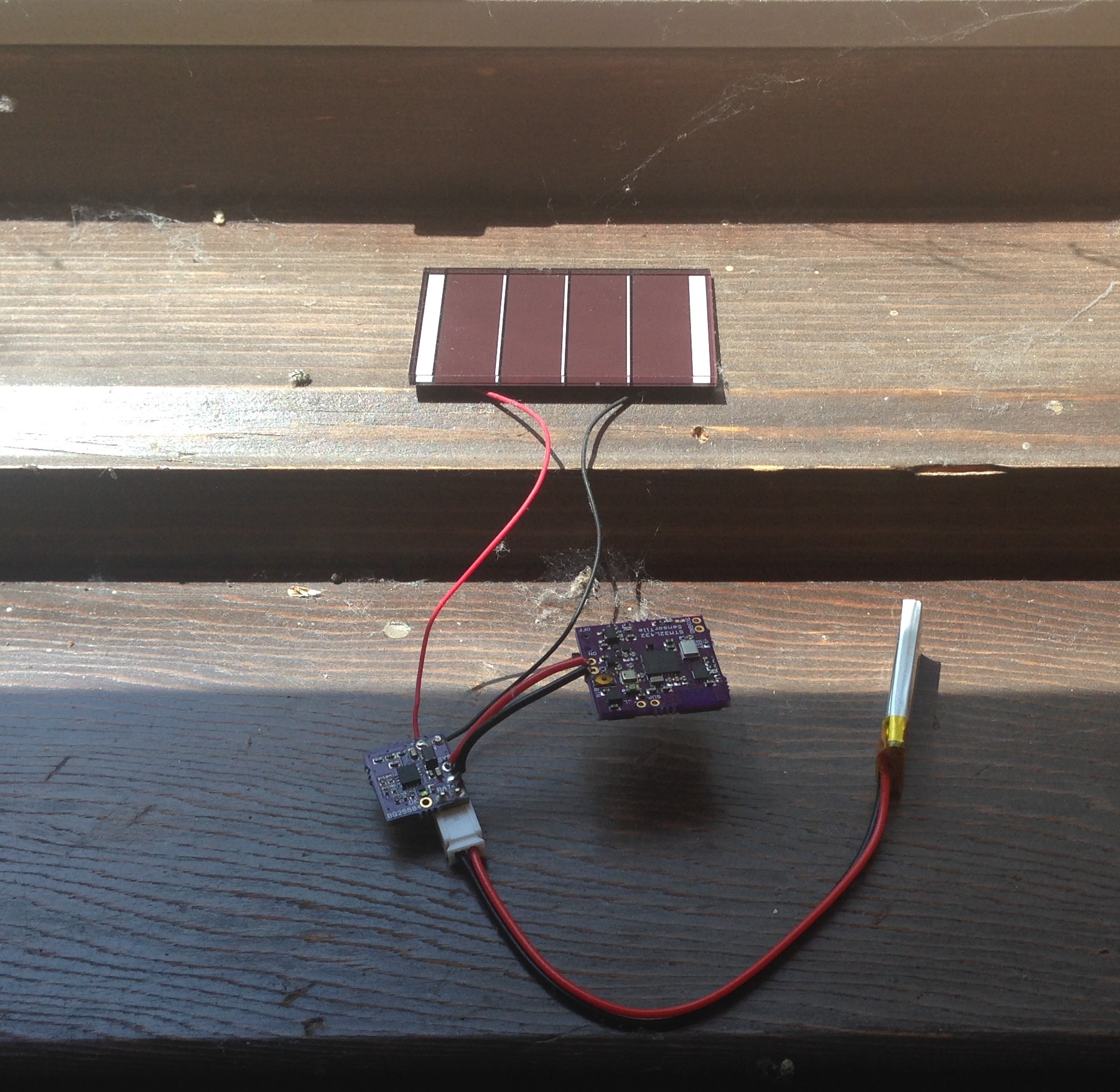08/08/17
First experiment using the BQ25504 solar cell LiPo charger with SensorTile2. I used the same sketch as I had run before where I was getting 100 hours of run time on a 150 mAH battery or 1.5 mA average power usage. This time I used a half-charged 105 mAH LiPo battery I just happened to have lying around to connect to the BQ25504 charger, and connected the BQ25004 system power and ground to the SensorTile2. I placed the whole apparatus on an inside window ledge where the sun shines directly for about three hours a day. This is the setup:

Cool spider webs, eh? The LiPo battery connects to the battery port of the BQ25504 breakout. The small 50 x 33 mm solar cell generates 40 mA @ 2.2V peak for 100 mW/cm^2 incident sunlight according to the specs. This location has direct (albeit somewhat oblique) sunlight for about three hours per day. Is this going to be enough to keep the Sensor Tile going?
In a word, no. First of all, the datasheet says 17 mA at 50,000 lux typical current. I am seeing peak ~5000 lux in this location. Three hours a day of 1.7 mA power is only 5.1 mA. I am consuming 1.5 mAH for the SensorTile2 plus 280 uAH for the battery OK led on the BQ25504 (which I should disable but haven't yet). So, 24 x 1.8 mA = 43 mA total consumed in 24 hours and 5.1 mA produced. This would be an average power usage of 1.57 mA.
Here is the actual results of the experiment:
 In direct sunlight, the ambient light sensor is pegged at 5500 lux (the VEML6040 has a maximum range of 16500 lux for integration time of 40 ms, whereas in this experiment I am using 160 ms*) so the actual intensity could be higher, but the direct sun only lasts ~3 hours or so at this window sill location. The BQ25504 definitely works, as the slight rises in charge level indicate while the sunlight is available. The half-charged 105 mAH LiPo battery lasted 43 hours which translates into ~1.2 mA average power usage. Really ~0.9 mA when we subtract off the 280 uA for the BQ25504 battery OK led. And this is a significant improvement over the 1.5 mA average power usage I was seeing without the BQ25504. Even the ~1.2 mA with OK led is better than the 1.57 mA I estimated above, so this likely means the actual light intensity is ~30% higher than the clipped peak measured. So likely closer to 7000 lux.
In direct sunlight, the ambient light sensor is pegged at 5500 lux (the VEML6040 has a maximum range of 16500 lux for integration time of 40 ms, whereas in this experiment I am using 160 ms*) so the actual intensity could be higher, but the direct sun only lasts ~3 hours or so at this window sill location. The BQ25504 definitely works, as the slight rises in charge level indicate while the sunlight is available. The half-charged 105 mAH LiPo battery lasted 43 hours which translates into ~1.2 mA average power usage. Really ~0.9 mA when we subtract off the 280 uA for the BQ25504 battery OK led. And this is a significant improvement over the 1.5 mA average power usage I was seeing without the BQ25504. Even the ~1.2 mA with OK led is better than the 1.57 mA I estimated above, so this likely means the actual light intensity is ~30% higher than the clipped peak measured. So likely closer to 7000 lux.
Could this scheme ever perpetually run the SensorTile2? Using a larger area solar cell, sure. But if I change location and position of this little solar cell, I would need to get 18,000 lux for six hours a day to produce ~37 mA per day and if I disable the BQ25504 led I would consume ~36 mA per day. So it is possible. But even if I could just double the run time from 100 to 200 hours total or so it might be worth the effort. I am running this experiment next.
* Yes, this is due to an error in the sketch where the sensitivity was being calculated as Gsensitivty/(integrationTime + 1) instead of Gsensitivity/(1 << integrationTime). So Gsensitivity was being divided by 3 and not the correct 4 at integration time of 160 ms.
 Kris Winer
Kris Winer
Discussions
Become a Hackaday.io Member
Create an account to leave a comment. Already have an account? Log In.